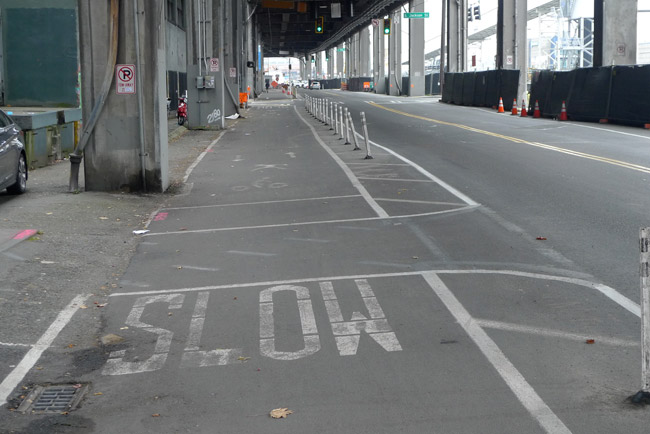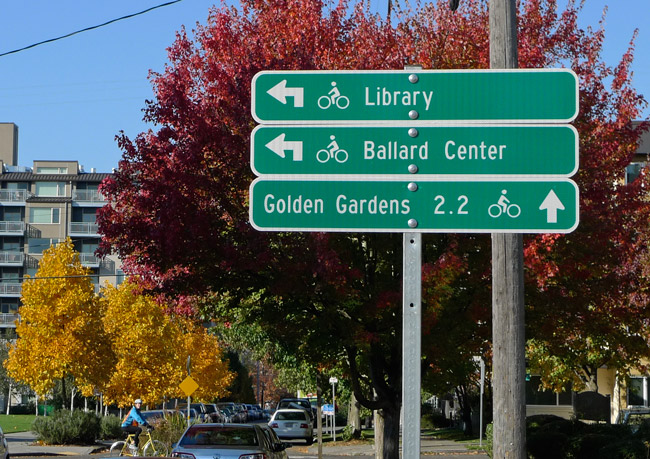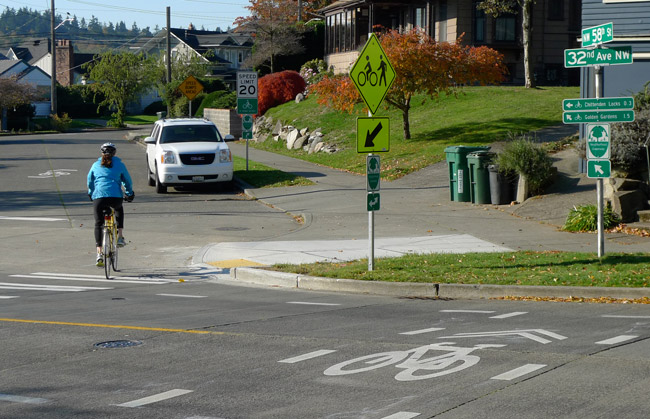Making Cycling Convenient (and Better!)

“Half of Copenhagen residents use bicycles to get to work or school. Not because these individuals are eco-friendly, young or sporty – but because bicycles are convenient and the fastest way to get around in the city.”
I was thinking about this statement from a mayor of Copenhagen as I rode along one of the new “protected” bike lanes in Seattle (above). In the U.S., less than 5% of trips are by bike, because cars remain the most convenient and fastest means of transportation. Our streets are wide with sufficient capacity, stores have ample parking, and usually the car is parked very close to our homes. For many North Americans, it’s hard to imagine just how inconvenient it is to drive (and how nearly impossible it is to park) in many European cities. For example, our photographer in Paris counts himself lucky to rent a garage space for his car which is only a 15 minute walk from his apartment.
We want to think that Copenhagen-style bicycle facilities will increase the bike-mode-share, but we are missing the point that people cycle in Copenhagen because it is too cumbersome and expensive to drive and park a car for everyday tasks.
In the U.S., cycling faces a much stiffer competition for mode share. We have two choices: either make cars slower and less convenient (like in Copenhagen), or make bikes faster and more convenient. I don’t think there is the political will to make driving less convenient in the U.S. yet. So we have to work on making cycling more convenient, faster and more pleasant.
Right now, the advocates of “Copenhagen-style” infrastructure call on cyclists to slow down, and to move off the street into separate lanes that purport to provide “safe” space, but where in reality they have to dodge parked cars and pedestrians. On some of Seattle’s new “protected” bike lanes, they even write “SLOW” on the pavement at regular intervals. Come on, we are cyclists – few of us can exceed the 20 mph speed limit anywhere, except perhaps on steep downhills. If I cannot even ride at 10-15 mph across town, then even I may choose to drive my car, or even walk instead. There must be a better way than designing facilities that have SLOW written all over them!

Fortunately, here in Seattle, popular bike routes are being converted into Neighborhood Greenways. It doesn’t take much – stop signs on cross-streets so that the cyclists have the right-of-way, and perhaps a few speed bumps to discourage cars from taking the “greenway” as a shortcut. The low cost means that these projects actually can be built quickly.
The result is amazing! One of these “greenways” is a route I take frequently. Because I now have the right-of-way, it’s much faster and more relaxing than before. I suspect that by providing a faster and pleasant, safe cycling environment, these “greenways” will get more people on bikes. It’s a brilliant idea, and I look forward to more of these.

In European cities like Copenhagen, many streets already have been closed for cars to create pedestrian zones, and there are no additional streets that can be turned over to cyclists, so they put the cyclists on the sidewalk. Here in North America, we can turn our weakness (low density, hence long distances and ample parking) into an asset (plenty of room for “Neighborhood Greenways”).
Even if cycling won’t be the most convenient or fastest way around Seattle, it’ll be the most pleasant, it’ll be safe, and it’ll fast enough to be viable.
Click here to read more posts about cycling safety, cyclepaths and bike lanes.


